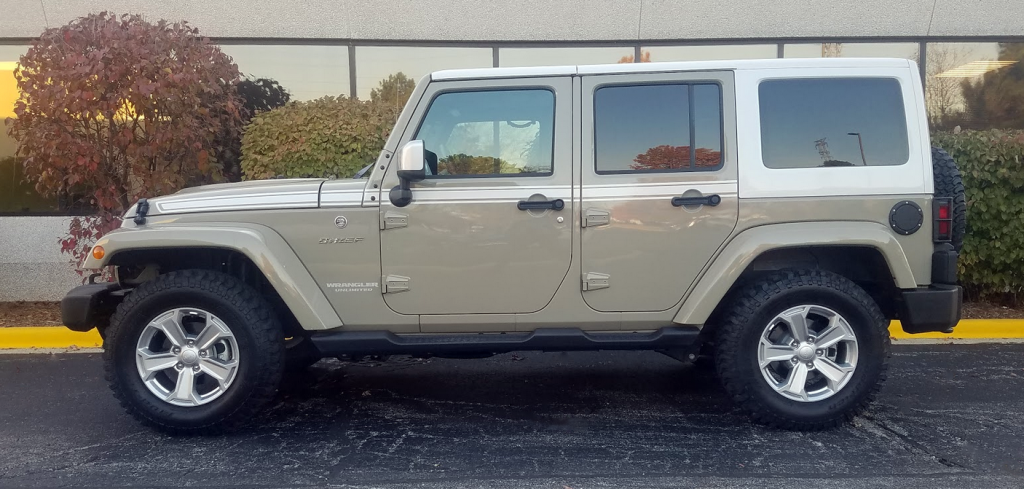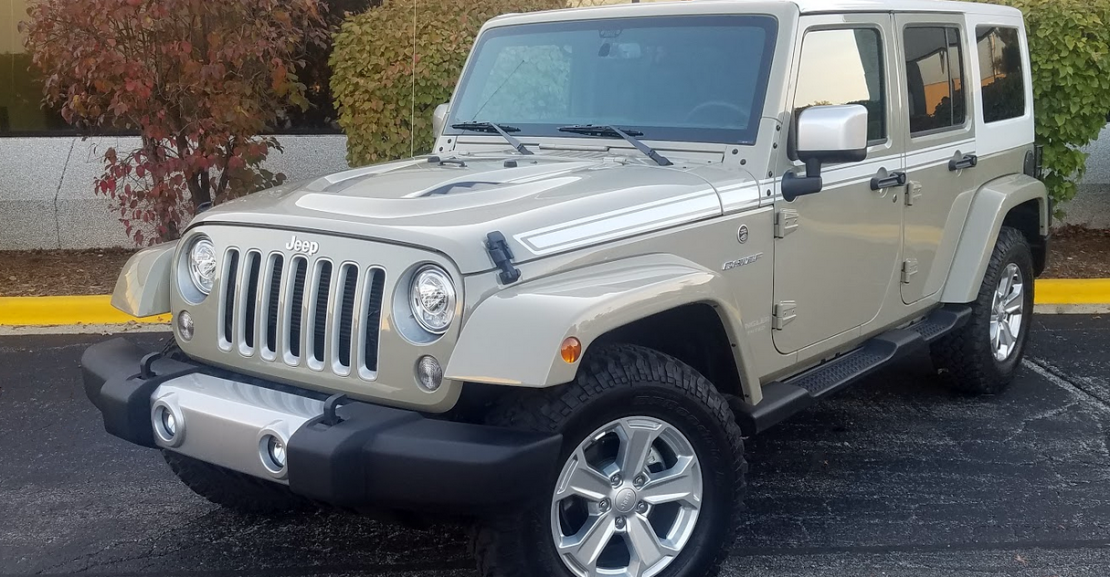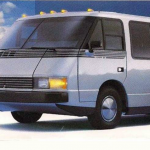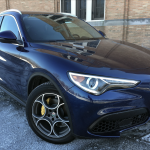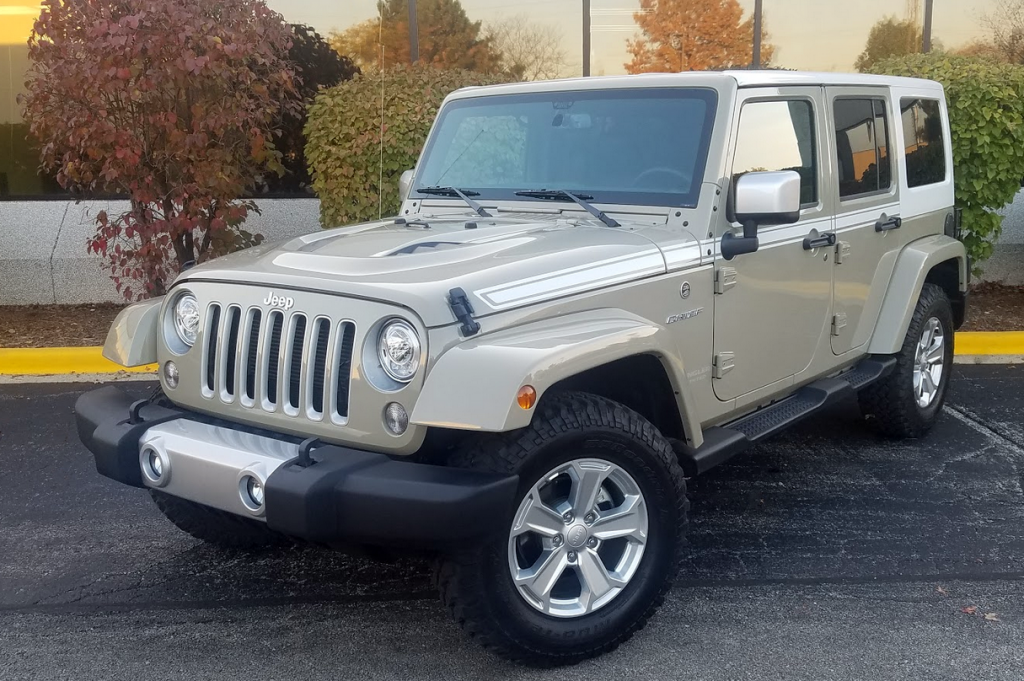
 2017 Jeep Wrangler Unlimited Chief 4X4
2017 Jeep Wrangler Unlimited Chief 4X4
Class: Compact SUV
Miles driven: 294
Fuel used: 18.6 gallons
Real-world fuel economy: 15.8 mpg
Driving mix: 50% city, 50% highway
EPA-estimated fuel economy: 16/20/18 (city, highway, combined)
| CG Report Card | |
|---|---|
| Room and Comfort | C |
| Power and Performance | C/A* |
| Fit and Finish | C+ |
| Fuel Economy | D |
| Value | C+ |
| Report-card grades are derived from a consensus of test-driver evaluations. All grades are versus other vehicles in the same class. Value grade is for specific trim level evaluated, and may not reflect Consumer Guide's impressions of the entire model lineup. | |
| Big & Tall Comfort | |
| Big Guy | C |
| Tall Guy | C+ |
| Big & Tall comfort ratings are for front seats only. "Big" rating based on male tester weighing approximately 350 pounds, "Tall" rating based on 6'6"-tall male tester. | |
Base price: $34,245 (not including $1095 destination charge)
Options on test vehicle: Chief Edition 24E appearance/equipment group ($4000), Connectivity Group ($695), Dual Top Group ($1190), Supplemental Front Seat-Mounted Side Airbags ($495), 5-Speed Automatic Transmission w/ Hill Descent Control ($1400), Trac-Lok rear axle ($495), Air Conditioning w/ Automatic Temperature Control ($395), radio package with navigation system and 40-gig hard drive ($1195), remote start ($495)
Price as tested: $45,700
Quick Hits
The great: One-of-a-kind nostalgic character, off-road prowess
The good: Open-air sunroof/removable-top capability
The not so good: Aged basic design, steep pricing, unrefined on-road performance
More Wrangler price and availability information
*On road/off road
Damon Bell
The completely redesigned, just-introduced 2018 Jeep Wrangler is getting the lion’s share of attention these days, and for good reason: It retains the Wrangler’s trademark personality and functionality while offering significant improvements in technology and all-around refinement.
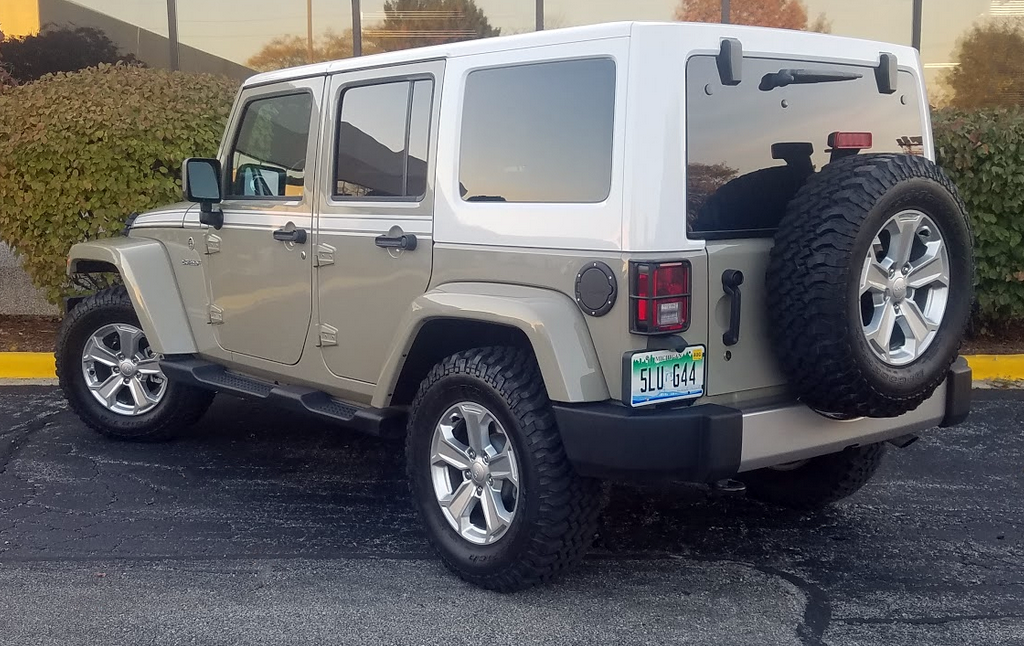
Test Drive: 2017 Toyota 4Runner TRD Off-Road
However, the previous-generation Wrangler continues for the 2018 model year as the Wrangler JK. (The JK suffix is Jeep’s code for the Wrangler’s generation; the new Wrangler is the “JL” generation.) Considering that the base prices on the JL have gone up around $3000 (!) compared to the JK on most of the Wrangler model lineup, choosing the previous-generation model is an attractive option for penny-pinching shoppers who want a brand-new Jeep on a slightly tighter budget.
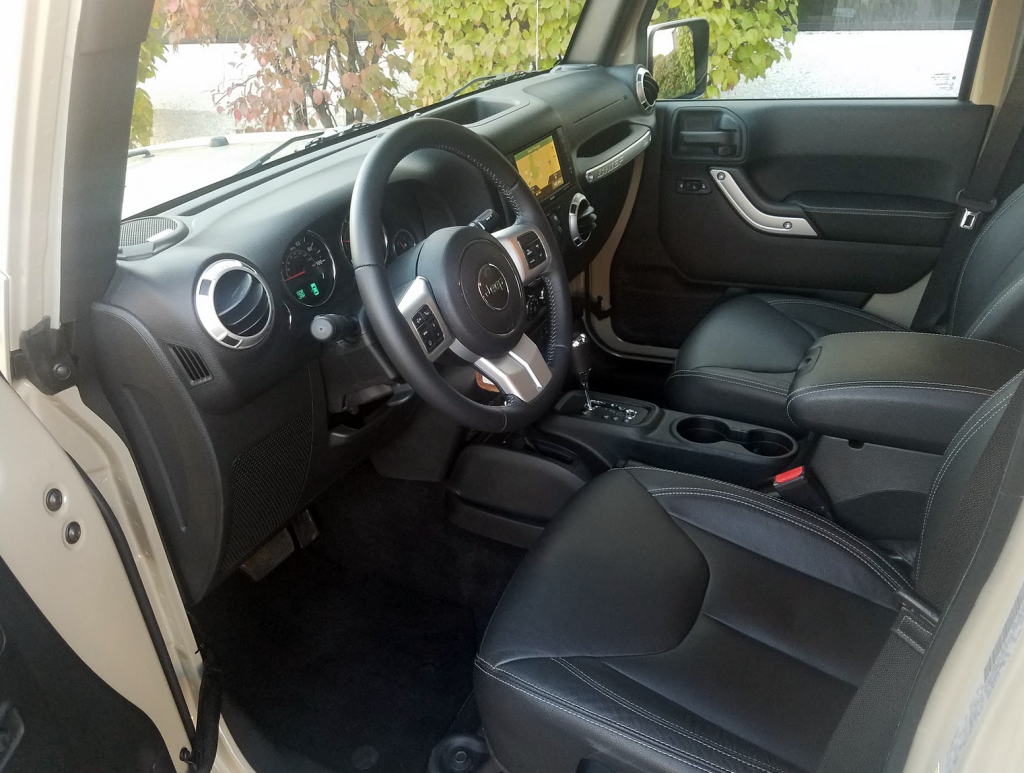
The 2017 Jeep Wrangler Unlimited Chief we recently had through our test fleet can serve as a stand-in for the 2018 Wrangler JK. It checked in at a bottom-line sticker price of $45,700, about $10,000 of which was optional equipment. Be a bit more careful with the options, and keeping the sticker price under $40K shouldn’t be too hard.
The JK Wrangler hasn’t received many significant updates since its introduction way back in 2006 as a 2007 model, and it shows. The navigation screen is smaller and less feature-rich than on most 2017 and 2018 vehicles, the gauge cluster’s digital graphics are more “Casio alarm clock” than “smartphone,” and many of the controls don’t operate with the precision of those in more-recently-designed interiors. Also, a rearview camera display—now a mandated feature on most new vehicles—isn’t available.
Simply getting behind the wheel of a Jeep Wrangler is an experience unlike any other new vehicle. The view out the flat windshield from the driver’s seat is unmistakable. The external hood hinges and latches, the front fenders, the two rubber bumpers (so you can flip the hood all the way back to rest on the windshield)—all of these are indicators that you’re driving a purpose-built machine with an unabashedly nostalgic feel.
The view out the rear window is restricted by the rear-seat headrests, the window-wiper motor, the spare tire, and the center high-mounted stoplight. The tall, boxy body shape means headroom is very good all-around, but front-seat legroom is tight for large occupants, and the footwells are rather narrow. The Wrangler’s body is a bit “shallow” below the beltline, so the high floor means that tall occupants will likely sit knees up. Rear legroom is very stingy behind a tall front-seater, and the rear seat backs are situated at an upright angle that may be uncomfortable for some. Entry and exit can also be challenging—the step-in height is high, and the door apertures are quite narrow, especially on the rear doors.
The ride is stiff and often “wallowy.” The steering ratio is tuned for minute, careful inputs in challenging off-road terrain. On road, that quick steering is almost TOO responsive; it can feel a bit “nervous” and require frequent corrective inputs when driving on the highway. Despite the direct steering, however, the Wrangler’s turning radius isn’t very tight for a vehicle its size. We found ourselves having to do some forward/reverse maneuvering to pull into a close-quarters parking spot or two during runs to the supermarket.
First Spin: 2018 Jeep Wrangler
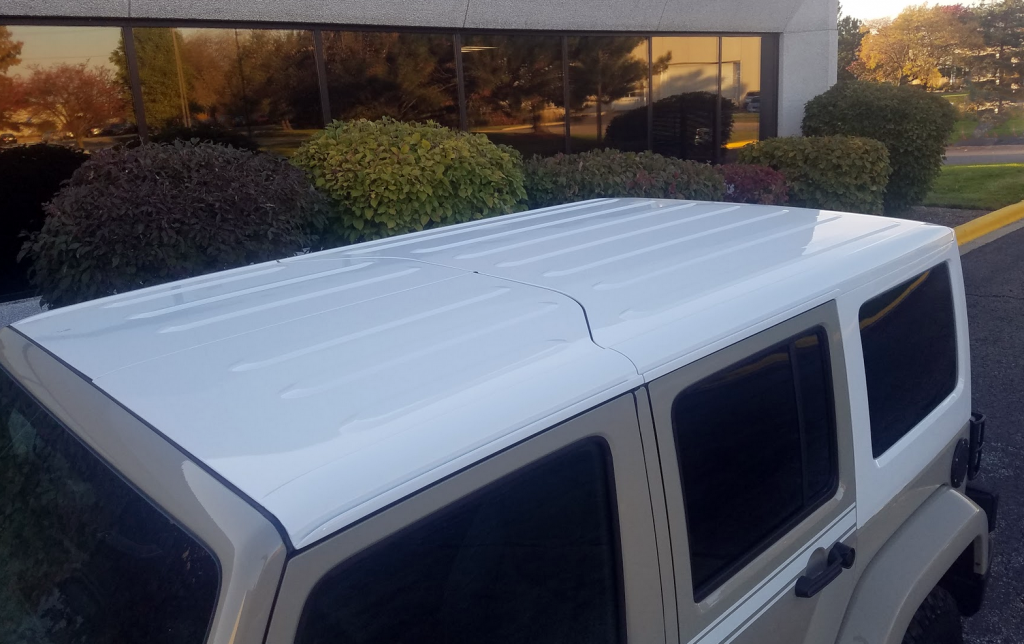
Noise levels are high all-around. The knobby BF Goodrich Mud-Terrain T/A tires can make quite a racket, especially at highway speeds. The growl from the V6 engine is always noticeable, and can grow intrusive when accelerating. Wind rush and general ambient noises are more pronounced than in other SUVs as well.
The acceleration is quite satisfying; the 285-hp 3.6-liter V6 supplies ample power, but the Wrangler’s dynamic shortcomings and copious thirst for gasoline kept us from dipping too deeply into the throttle. Even though we took it fairly easy, we only averaged 15 mpg in a test that consisted of about 65 percent city driving. We haven’t had the new 2018 “JL” Wrangler in for fuel-economy testing just yet, but its numbers will certainly be superior, thanks in part to a fuel-saving engine start/stop feature and an 8-speed automatic transmission in place of this aged 5-speed.
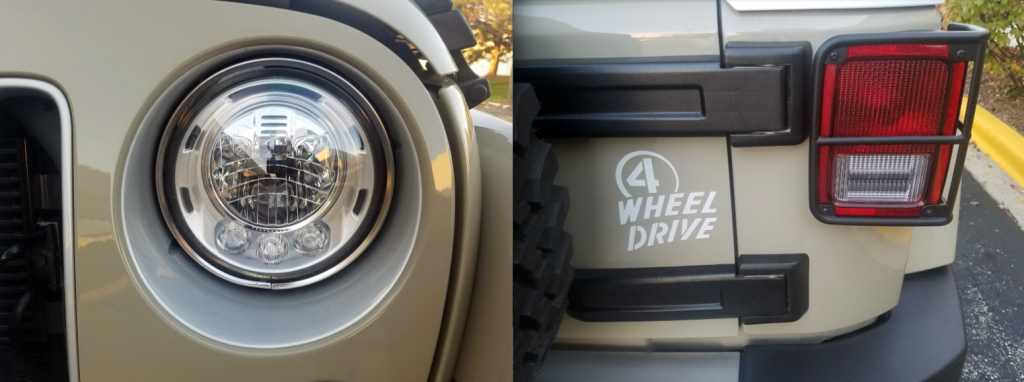
The Wrangler eschews many modern-day design features in favor of deliberately old-school elements that demand a bit more user involvement (and, in some cases, good ol’ manual labor). The door hinges don’t have detents; there are fabric retainer straps instead. This means that the doors often won’t always stay open on their own, and often need to be propped open by you—this can be a pain on a windy day, or when you’re parked on an incline. The doors also require a stronger-than-normal push for them to close and latch fully. Likewise, The swing-out tailgate and lift-up rear glass are more tedious than a traditional liftgate. And though the Wrangler offers unmatched open-air, fun-in-the-sun capability, the lift-off hardtop and folding soft-top options are fairly difficult to use without lots of practice. Diehard Wrangler enthusiasts don’t seem to mind; they shrug off stuff like this by saying, “It’s a Jeep thing… you wouldn’t understand.” (Also, it should be noted that the redesigned ’18 Wrangler vastly improves many of these quirks.)
The JK-generation Wrangler might be the closest thing to a farm implement you can buy as an over-the-road passenger vehicle in 2018, but that’s part of its charm. You automatically feel a bit more rugged and adventurous just by driving one.
